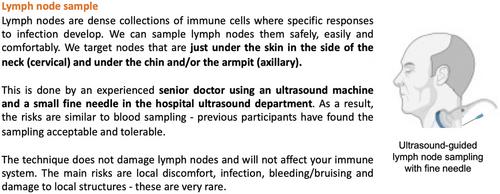{"title":"多部位超声引导细针抽吸法研究人体淋巴结的细胞和可溶性因子","authors":"Adam Al-Diwani, Deepsha Agrawal, Fintan Sheerin, Callum Board, Sarosh R. Irani, Katrina M. Pollock, Nicholas M. Provine","doi":"10.1002/cpz1.70063","DOIUrl":null,"url":null,"abstract":"<p>Lymph nodes (LNs) are specialized secondary lymphoid tissues essential to the priming and maintenance of adaptive immune responses, including the B cell germinal center response; thus, they are central to immunity. However, the anatomically restricted and time-resolved nature of immune priming means that sampling disease-relevant human LNs requires specialized techniques. This article describes the application of ultrasound-guided fine-needle aspiration (FNA) to sample LNs, using cervical LNs of the head and neck as an exemplar. This minimally invasive technique allows collection of both immune cells and cell-free material that are relevant to both neuroimmune diseases and basic lymphatic functions. Downstream use of cellular material can include multiplexed flow cytometry, single-cell transcriptome sequencing (RNA-seq), and B cell cultures. The cell-free supernatant can be used for proteomics or other similar ‘omics approaches. This unit describes collection of samples by FNA as well as processing and storage of samples for downstream assays. © 2024 The Author(s). Current Protocols published by Wiley Periodicals LLC.</p><p><b>Basic Protocol 1</b>: Sampling of human cervical lymph nodes by ultrasound-guided fine-needle aspiration</p><p><b>Alternate Protocol</b>: Sampling of human lymph nodes by ultrasound-guided fine-needle aspiration with negative pressure</p><p><b>Basic Protocol 2</b>: Processing and storage of human lymph node samples</p>","PeriodicalId":93970,"journal":{"name":"Current protocols","volume":"4 11","pages":""},"PeriodicalIF":0.0000,"publicationDate":"2024-11-23","publicationTypes":"Journal Article","fieldsOfStudy":null,"isOpenAccess":false,"openAccessPdf":"https://onlinelibrary.wiley.com/doi/epdf/10.1002/cpz1.70063","citationCount":"0","resultStr":"{\"title\":\"Multi-site Ultrasound-guided Fine Needle Aspiration to Study Cells and Soluble Factors From Human Lymph Nodes\",\"authors\":\"Adam Al-Diwani, Deepsha Agrawal, Fintan Sheerin, Callum Board, Sarosh R. Irani, Katrina M. Pollock, Nicholas M. Provine\",\"doi\":\"10.1002/cpz1.70063\",\"DOIUrl\":null,\"url\":null,\"abstract\":\"<p>Lymph nodes (LNs) are specialized secondary lymphoid tissues essential to the priming and maintenance of adaptive immune responses, including the B cell germinal center response; thus, they are central to immunity. However, the anatomically restricted and time-resolved nature of immune priming means that sampling disease-relevant human LNs requires specialized techniques. This article describes the application of ultrasound-guided fine-needle aspiration (FNA) to sample LNs, using cervical LNs of the head and neck as an exemplar. This minimally invasive technique allows collection of both immune cells and cell-free material that are relevant to both neuroimmune diseases and basic lymphatic functions. Downstream use of cellular material can include multiplexed flow cytometry, single-cell transcriptome sequencing (RNA-seq), and B cell cultures. The cell-free supernatant can be used for proteomics or other similar ‘omics approaches. This unit describes collection of samples by FNA as well as processing and storage of samples for downstream assays. © 2024 The Author(s). Current Protocols published by Wiley Periodicals LLC.</p><p><b>Basic Protocol 1</b>: Sampling of human cervical lymph nodes by ultrasound-guided fine-needle aspiration</p><p><b>Alternate Protocol</b>: Sampling of human lymph nodes by ultrasound-guided fine-needle aspiration with negative pressure</p><p><b>Basic Protocol 2</b>: Processing and storage of human lymph node samples</p>\",\"PeriodicalId\":93970,\"journal\":{\"name\":\"Current protocols\",\"volume\":\"4 11\",\"pages\":\"\"},\"PeriodicalIF\":0.0000,\"publicationDate\":\"2024-11-23\",\"publicationTypes\":\"Journal Article\",\"fieldsOfStudy\":null,\"isOpenAccess\":false,\"openAccessPdf\":\"https://onlinelibrary.wiley.com/doi/epdf/10.1002/cpz1.70063\",\"citationCount\":\"0\",\"resultStr\":null,\"platform\":\"Semanticscholar\",\"paperid\":null,\"PeriodicalName\":\"Current protocols\",\"FirstCategoryId\":\"1085\",\"ListUrlMain\":\"https://onlinelibrary.wiley.com/doi/10.1002/cpz1.70063\",\"RegionNum\":0,\"RegionCategory\":null,\"ArticlePicture\":[],\"TitleCN\":null,\"AbstractTextCN\":null,\"PMCID\":null,\"EPubDate\":\"\",\"PubModel\":\"\",\"JCR\":\"\",\"JCRName\":\"\",\"Score\":null,\"Total\":0}","platform":"Semanticscholar","paperid":null,"PeriodicalName":"Current protocols","FirstCategoryId":"1085","ListUrlMain":"https://onlinelibrary.wiley.com/doi/10.1002/cpz1.70063","RegionNum":0,"RegionCategory":null,"ArticlePicture":[],"TitleCN":null,"AbstractTextCN":null,"PMCID":null,"EPubDate":"","PubModel":"","JCR":"","JCRName":"","Score":null,"Total":0}
引用次数: 0


